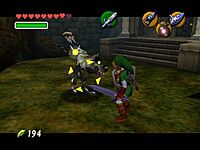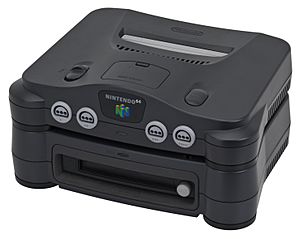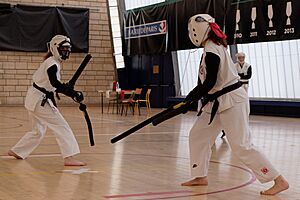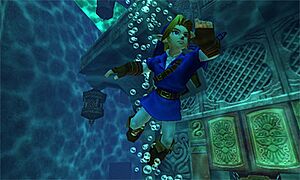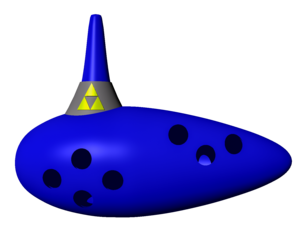The Legend of Zelda: Ocarina of Time facts for kids
Quick facts for kids The Legend of Zelda:Ocarina of Time |
|
|---|---|

North American box art
|
|
| Developer(s) | Nintendo EAD |
| Publisher(s) | Nintendo |
| Director(s) |
|
| Producer(s) | Shigeru Miyamoto |
| Programmer(s) | Kenzo Hayakawa |
| Artist(s) |
|
| Writer(s) |
|
| Composer(s) | Koji Kondo |
| Series | The Legend of Zelda |
| Platform(s) | |
| Release date(s) |
November 21, 1998
Nintendo 64
GameCube
iQue Player
|
| Genre(s) | Action-adventure |
| Mode(s) | Single-player |
The Legend of Zelda: Ocarina of Time is an exciting action-adventure game released in 1998 for the Nintendo 64. It was created by Nintendo and was the first game in the famous The Legend of Zelda series to use 3D graphics.
The game was made by a team at Nintendo EAD. Five directors, including Eiji Aonuma and Yoshiaki Koizumi, helped lead the project. Shigeru Miyamoto, who helped create the Zelda series, was the producer. Koji Kondo, a well-known composer for Zelda games, wrote the music.
In the game, you play as Link in the magical land of Hyrule. Your mission is to stop the evil king Ganondorf. You'll travel through time, explore tricky dungeons, and journey across a big world. The game introduced cool new features like a way to lock onto enemies and smart buttons that change what they do. You also get to play songs on a special instrument called an ocarina to help you on your quest.
Ocarina of Time was a huge hit with players and critics. People loved its graphics, sounds, gameplay, music, and story. It won many awards and is often called one of the greatest video games ever made. It sold over seven million copies around the world. It even set a record for pre-orders in the United States!
A direct sequel, The Legend of Zelda: Majora's Mask, came out in 2000. Ocarina of Time has been re-released on almost all of Nintendo's home consoles. An improved version for the Nintendo 3DS, called The Legend of Zelda: Ocarina of Time 3D, was released in 2011. There's also a harder version called Master Quest with new puzzles.
Contents
How to Play: Exploring Hyrule
The Legend of Zelda: Ocarina of Time is a fantasy action-adventure game set in a big 3D world. You control Link from a view behind him. Link mostly fights with a sword and shield. He can also use other cool items like bombs, arrows, and magic spells.
The game has a special "Z-targeting" system. This lets Link focus on enemies or objects. When you use it, the camera follows your target. Link always faces them, making it easier to attack. Projectile attacks, like arrows, automatically aim at the target.
The game also uses "context-sensitive" buttons. This means one button can do different things. What it does depends on what Link is doing. For example, the same button might make Link push a box or climb on it. This makes the controls simple and easy to learn.
You'll spend a lot of time exploring and fighting. But some parts of the game need you to be sneaky. Link gets new abilities by finding items and weapons. These are hidden in dungeons or found in the main world. There are also side quests that give you special rewards. For example, you can get the powerful Biggoron Sword. You can also get a horse named Epona. She helps you travel faster across Hyrule Field.
The Magic of the Ocarina
Early in the game, Link gets an ocarina. Later, he finds the special Ocarina of Time. Throughout your adventure, Link learns twelve different songs. These songs help him solve puzzles and travel quickly to places he's already visited.
The Ocarina of Time is also used to get the Master Sword. When Link pulls the Master Sword, he travels seven years into the future. He becomes an adult! Young Link and adult Link have different skills. For example, only adult Link can use the Fairy Bow. Only young Link can fit into small spaces. After you complete certain tasks, you can travel between these two time periods.
The Story of Hyrule
Where the Adventure Happens
Ocarina of Time takes place in the fantasy kingdom of Hyrule. This is where most Legend of Zelda games are set. Hyrule Field is the main area. It connects to many different places. These areas have unique landscapes and are home to the various races of Hyrule.
Link's Epic Journey
The story begins with a fairy named Navi. She wakes Link from a bad dream. In the dream, he sees a man in black armor chasing a young girl. Navi takes Link to the Great Deku Tree. The tree is dying because of a curse. The Deku Tree tells Link that a "wicked man of the desert" cursed him. Link must stop this man from taking over the world. Before he dies, the Great Deku Tree gives Link a special stone. He sends Link to Hyrule Castle to meet the princess.
At Hyrule Castle, Link meets Princess Zelda. She believes Ganondorf, the evil king of the Gerudo tribe, wants the Triforce. The Triforce is a holy relic that gives its owner amazing power. Zelda asks Link to find three special stones. These stones will let them enter the Sacred Realm and get the Triforce before Ganondorf. Link collects the other two stones. One is from Darunia, the leader of the Gorons. The other is from Ruto, the princess of the Zoras.
Link returns to Hyrule Castle. He sees Ganondorf chasing Zelda and her protector, Impa. It's just like his nightmare! Link tries to stop Ganondorf but fails. Inside the Temple of Time, Link uses the Ocarina of Time, a gift from Zelda, and the three stones. This opens the door to the Sacred Realm. There, he finds the Master Sword. But when he pulls it out, he falls unconscious. Ganondorf, who followed Link, appears and takes the Triforce.
Seven years later, an older Link wakes up in the Sacred Realm. He meets Rauru, one of the seven Sages. Rauru explains that Link's spirit was sealed away. This was so he could grow up and be strong enough to use the Master Sword. Ganondorf has taken over Hyrule during this time. The Sages can trap Ganondorf in the Sacred Realm. But five of them don't know they are Sages yet.
Link returns to the Temple of Time. He meets a mysterious person named Sheik. Sheik guides him to free five temples from Ganondorf's control. This helps the Sages awaken. Link had befriended all five Sages as a child. They are Saria (Forest Temple), Darunia (Fire Temple), Ruto (Water Temple), Impa (Shadow Temple), and Nabooru (Spirit Temple). After the five Sages awaken, Sheik reveals herself to be Zelda in disguise. She is the seventh Sage. She explains that Ganondorf's heart was unbalanced. This caused the Triforce to split into three pieces. Ganondorf only got the Triforce of Power. Zelda received the Triforce of Wisdom, and Link got the Triforce of Courage.
Ganondorf appears and captures Zelda. He traps her in a giant crystal in his castle. The other six Sages help Link enter the castle. Link frees Zelda after defeating Ganondorf. Ganondorf then destroys his castle to try and kill Link and Zelda. They escape the collapsing castle. But Ganondorf rises from the rubble. He uses the Triforce of Power to turn into a giant boar-like beast named Ganon. Ganon knocks the Master Sword from Link's hand. But with Zelda's help, Link gets the sword back and defeats Ganon.
The seven Sages seal Ganondorf in the Sacred Realm. He promises to get revenge on their descendants. Zelda uses the Ocarina of Time to send Link back to his childhood. Navi leaves Link. Young Link meets Zelda in the castle garden again. He still remembers what happened to Hyrule. This helps prevent the bad future from happening.
How the Game Was Made
Ocarina of Time was made at the same time as Super Mario 64 and Mario Kart 64. It was developed for the Nintendo 64 by Nintendo's EAD team. The game cost over $12 million to make and had more than 200 people working on it.
The game was first planned for a disk drive called the 64DD. But it needed to store a lot of data. So, the team moved it to a game cartridge instead. The game's size grew from 16 to 32 megabytes. This made it Nintendo's biggest game ever at the time.
Shigeru Miyamoto, who helped create the Zelda series, was the producer. He oversaw five different directors. This was a new way of working for Nintendo EAD. Different teams worked on different parts of the game. This included the story, Link's actions, and turning 2D items into 3D. They also worked on the camera, sound, and special effects. Eiji Aonuma designed the game's dungeons.
The team was new to making 3D games. But they were very excited to create something new. Miyamoto traveled to Germany to get ideas for Hyrule Castle's market. He liked the half-timbered buildings there. Even though the game is a medieval fantasy, Miyamoto used Japanese chanbara (samurai) sword fighting as a model for combat. Over 120 people worked on the game. This included stunt performers who helped with sword fighting moves.
Miyamoto first wanted the game to be in a first-person view. This would let players see the huge Hyrule Field better. But then the idea of a child Link came up. Miyamoto felt it was important to see Link on screen. So, they changed it to a third-person view.
The "Z-targeting" system was first just a simple marker. But Yoshiaki Koizumi changed it to a fairy. This made it feel less like a robot. The fairy was called the "Fairy Navigation System." This later became the name "Navi." Navi then became an important character in the story.
Miyamoto wanted the game to feel like a movie, but still be a game. The cutscenes in Ocarina of Time are made in real-time by the Nintendo 64. They are not pre-recorded videos. This allowed the team to change the story easily. They could also add new gameplay elements even close to the end of development.
Some of Miyamoto's ideas were used in Super Mario 64 instead. Other ideas were cut because of time. For example, a shopkeeper character was changed into the Deku Scrubs. The game's camera is mostly controlled by the game's computer. This is different from Super Mario 64, where players control the camera a lot. Miyamoto wanted Ocarina of Time to be easy enough for all players. He wanted it to be easier than Super Mario 64.
The Music of Hyrule
The music for Ocarina of Time was created by Koji Kondo. He is the main composer for most The Legend of Zelda games. Not only do characters have their own music, but different areas of Hyrule also have special tunes. When you enter a new area, the music helps set the mood. In some places, the music is a different version of a song Link learns on his ocarina.
Music is very important to the gameplay. The buttons on the Nintendo 64 controller look like the holes on the ocarina in the game. Players must learn to play many songs to finish the game. All songs use five notes. But you can bend the notes using the analog stick to make more sounds. Kondo said making different songs with limited notes was a "major challenge." But he felt the result was very natural. The game's popularity even made ocarina sales go up!
The official soundtrack was released in Japan in 1998. It had 82 songs. A U.S. version was also released, but with fewer songs. Many critics loved the music. GameSpot called it one of the top ten video game soundtracks in 2001. The original music for the Fire Temple was changed in later versions of the game. This was because Nintendo avoids real religious references in their products. The new version removed some chanting sounds.
Game Release and Updates
Ocarina of Time was first shown in a video in 1995. Nintendo planned to release it for the 64DD disk drive. But problems with the 64DD meant the game was moved to a cartridge. This caused delays, and the game missed its 1997 release date. It came out in 1998 instead.
In the late 1990s, the Nintendo 64 needed a big hit game. Zelda was one of the most anticipated games. Many believed the Nintendo 64's future depended on it. Nintendo spent $10 million on marketing Ocarina of Time.
Customers in North America who pre-ordered the game got a special gold-colored cartridge. This was a tradition from the first Legend of Zelda game. Demand was so high that stores stopped taking pre-orders!
Several versions of Ocarina of Time were made. Later versions had small changes. For example, Ganondorf's blood was changed from red to green. The Fire Temple music was also changed to remove a sample of an Islamic prayer. This was done because Nintendo has a policy against religious material.
Re-releases and Remakes
Nintendo later brought Ocarina of Time to its next console, the GameCube. It was part of a collection of Zelda games. This version was an emulation of the original Nintendo 64 game. Another GameCube release included the original game and a harder version called Master Quest. This was a bonus for pre-ordering The Legend of Zelda: The Wind Waker. In 2003, Ocarina of Time was also released for China's iQue Player.
In 2007, Ocarina of Time came to the Wii Virtual Console. This was also an emulation of the Nintendo 64 version. In 2015, it was re-released on the Wii U Virtual Console. This time, it included the original controller vibration. It also came to the Nintendo Switch Online + Expansion Pack in 2021.
Nintendo 3DS Remake
In 2011, Nintendo released Ocarina of Time 3D for the Nintendo 3DS handheld console. This was an enhanced port with improved graphics. It was made by Nintendo EAD and Grezzo. This version includes Master Quest. It also adds new features like touchscreen controls and a "Boss Challenge" mode. There are also helpful videos for players who get stuck. The Water Temple, known for being tricky, was made a bit easier.
Master Quest: A Harder Challenge
After finishing Ocarina of Time, Nintendo started making a new version. It was called Ura Zelda, meaning "Another Zelda." This version was for the 64DD peripheral. It was meant to have rearranged and harder dungeons. It also included some content that was cut from the original game. But the 64DD had problems, and Ura Zelda was put on hold. It was later canceled because the 64DD didn't sell well.
In 2002, Ura Zelda was finally released on the GameCube in Japan. It was called The Legend of Zelda: Ocarina of Time Master Quest in North America and Europe. Master Quest uses the same game engine and story as Ocarina of Time. But it has much harder puzzles and dungeons.
Critics generally liked Master Quest. They compared it to the "second quest" in the first Legend of Zelda game. Some felt that certain redesigned areas weren't as good as the original. But overall, it was seen as a great bonus for Zelda fans. The graphics were improved, but the controls felt a bit clumsy on the GameCube controller. Still, many praised the new puzzles. They required careful timing and clever use of items.
How Ocarina of Time Changed Gaming
After it came out, Ocarina of Time was often listed as one of the best and most important games ever. Many publications called it the greatest video game of all time. It appeared on "greatest games" lists from Electronic Gaming Monthly and IGN. Official Nintendo Magazine ranked it second in its "100 greatest Nintendo games," after Super Mario Bros..
In 2011, IGN held a competition where fans voted Ocarina of Time the greatest Zelda game. It won against Majora's Mask in the final round. Edge magazine has consistently placed Ocarina of Time at number one on its "top 100 games" lists. In 2022, The Strong National Museum of Play added Ocarina of Time to its World Video Game Hall of Fame.
The re-releases of Ocarina of Time were also well-received. While some thought the graphics and sound were a bit old, most agreed the game had aged well. IGN said that "Ocarina of Time has aged extremely well." They noted that even though textures looked old, the overall look of the game still held up. Game Revolution said it was "still a terrific game."
In 2021, fans completely broke down the game's code. In 2022, a group released a PC version called "Ship of Harkinian." This version has widescreen support and a faster framerate.
Its Big Impact on Games
The Legend of Zelda: Ocarina of Time introduced and made popular many gameplay features. These include the target-lock system and context-sensitive buttons. These features are now common in many 3D adventure games.
Many people in the video game industry have said how much this game influenced them. Dan Houser from Rockstar Games said that any 3D game maker who claims they haven't borrowed from Mario or Zelda on the Nintendo 64 is "lying." His brother, Sam Houser, said Grand Theft Auto III was like "Zelda meets Goodfellas."
Hideki Kamiya, who directed Ōkami, said he was influenced by Zelda. Amy Hennig, who directed Soul Reaver and Uncharted, also said Zelda influenced her work. Hidetaka Miyazaki, the creator of Dark Souls, called The Legend of Zelda a "textbook for 3D action games."
Fumito Ueda, director of Ico, said Zelda influenced Shadow of the Colossus. David Adams, director of Darksiders, also cited Zelda as an influence. CD Projekt Red, who made The Witcher series, said Zelda influenced their games. Hajime Tabata, director of Final Fantasy XV, said Ocarina of Time inspired the open world of his game.
Images for kids
See also
 In Spanish: The Legend of Zelda: Ocarina of Time para niños
In Spanish: The Legend of Zelda: Ocarina of Time para niños



